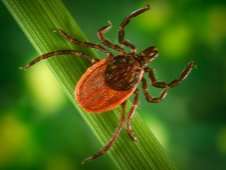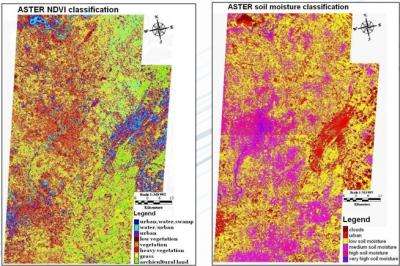Students Use Satellites to Check for Ticks

(PhysOrg.com) -- Using state-of-the-art NASA satellite information, about a dozen students from the University of Alabama at Birmingham and Jacksonville State University in Jacksonville, Ala., are busy checking state forests for ticks that may carry Lyme disease.
The students, participating in a NASA program called DEVELOP, have spent three school terms looking at habitats favorable for the proliferation of the blood-sucking insects.
DEVELOP is a mentorship and training program sponsored by the Applied Sciences Program in NASA's Earth Science Division of the Science Mission Directorate in Washington, D.C. DEVELOP engages students in scientific fieldwork and lab study and teaches them how to analyze research results and share them with scientific and public communities.
The students deliver research results, measurements and predictions that address local policy and environmental concerns, and develop professional-caliber products to aid community leaders and local and state governments with decision-making. In the process, the students gain real-world research experience -- and the capability to contribute immediately to the science community.
Dr. Jeffrey Luvall, a senior research scientist at NASA's Marshall Space Flight Center in Huntsville, Ala., mentors students in the DEVELOP program. "NASA is committed to inspiring young people in science, technology, engineering and math,” Luvall said. “The DEVELOP program offers a dual benefit -- encouraging students to pursue careers in technical fields, and helping communities and states through expanded use of NASA satellite information."
During the summer of 2009 through spring 2010 sessions, students chose to work with NASA's satellite-based, remote-sensing technology, and geographic information systems software to focus on research into Lyme disease. The disease can become a serious, chronic illness in humans when undiagnosed and untreated.
NASA's Advanced Space borne Thermal Emission and Reflection Radiometer (ASTER) sensor was utilized along with the USGS-partnered Landsat, and digital Globe's Quickbird satellite. Students used the satellite imagery to analyze soil moisture and vegetation at 12 locations in the Talladega National Forest in north-central Alabama, creating detailed digital maps and images showing conditions on the ground that could support habitats for carriers of Lyme disease: blacklegged ticks (deer ticks). Important hosts for these ticks include: white-tailed deer; and the white-footed mouse. Results of their satellite imagery analysis showed areas of dense vegetation overlapped with high soil moisture -- likely tick habitats.

As the final element of their DEVELOP program work, participating students are establishing venues to directly educate the public about Lyme disease. This summer, they will work with Girl Scout troops and camps around northern Alabama, providing scouts and adult supervisors with information about tick-borne diseases and prevention methods. Additionally, student researchers attend conferences to convey what they have learned, increasing awareness not just of the serious risk of Lyme disease exposure, but also of the DEVELOP program itself. Their outreach effort helps NASA to recruit new groups of potential applicants and explore future research topics and collaborations.
The DEVELOP program, led by NASA's Langley Research Center in Hampton, Va., is active at five NASA facilities: Marshall Space Flight Center; Ames Research Center in Moffett Field, Calif.; Goddard Space Flight Center in Greenbelt, Md.; Stennis Space Center near Bay St. Louis, Miss.; and the Jet Propulsion Laboratory in Pasadena, Calif. Internship opportunities with the program are available during the spring, summer and fall. High school, undergraduate and graduate students with strong interests in science, technology and government policymaking are encouraged to apply.
Provided by JPL/NASA


















